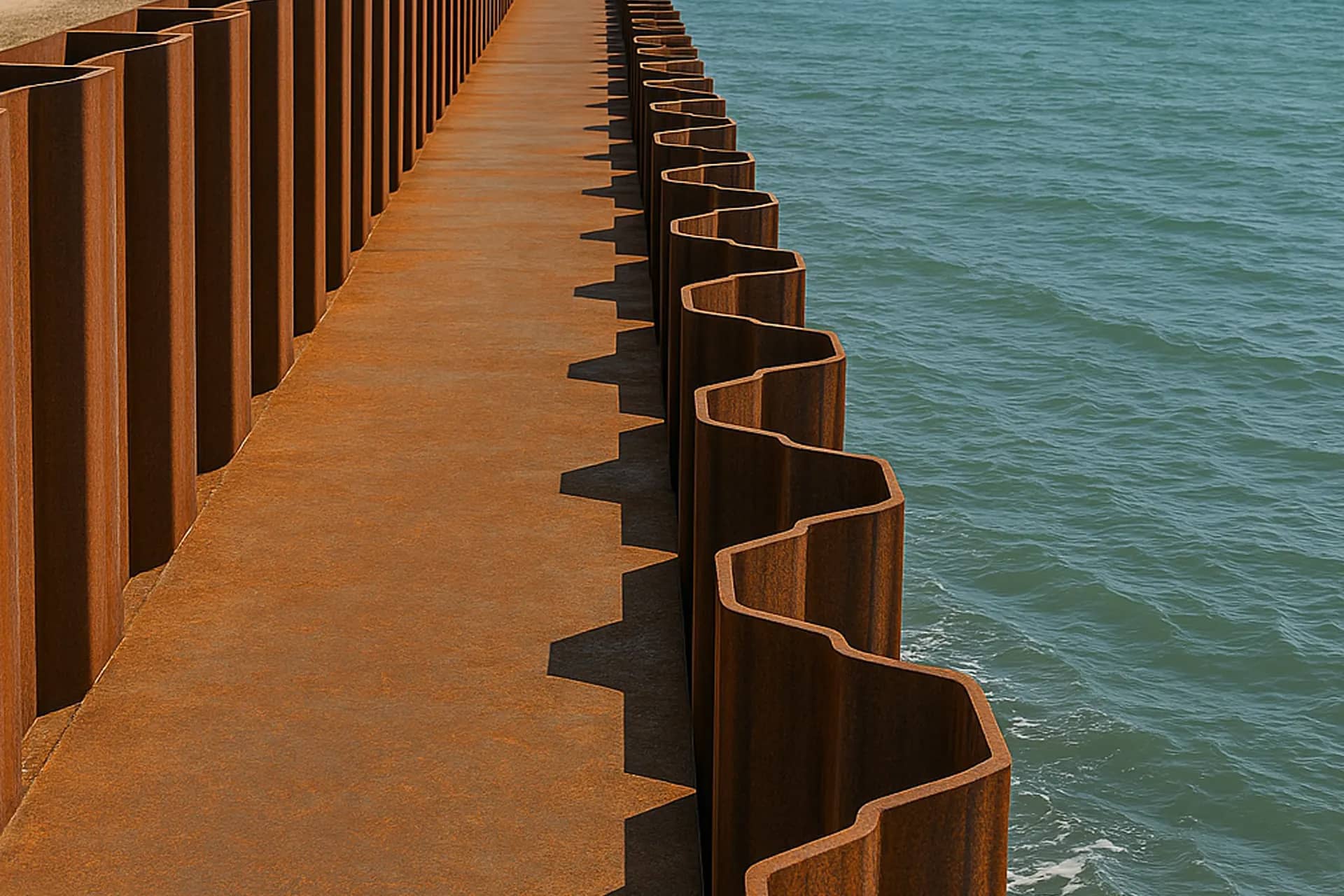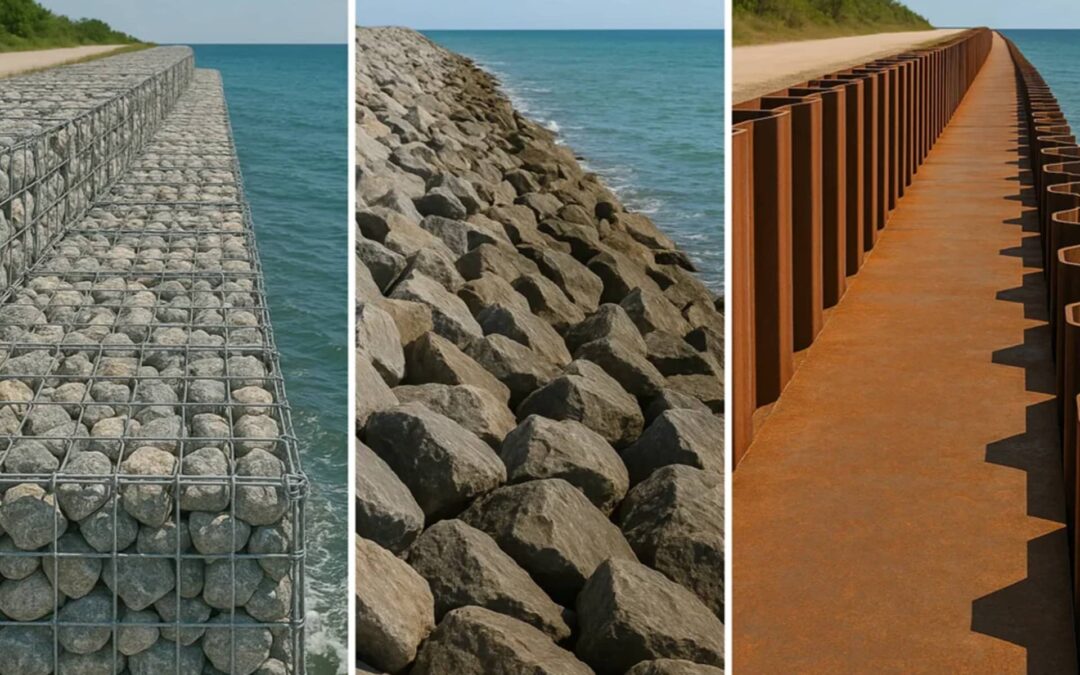Coastal property owners across Long Island and New York’s waterfronts face a constant battle against erosion, rising tides, and wave impact. Choosing the right shoreline protection system isn’t just about cost. It’s about long-term performance, safety, and environmental compliance.
Whether you own a home along Great South Bay or manage a marina on the North Shore, understanding the strengths and limitations of sheet pile walls, gabion walls, and riprap revetments can help you make a smarter, more durable investment in your shoreline.
Protect Your Waterfront Property With Engineered Coastal Solutions! Contact Zavza Seal Today for a Free On-Site Assessment.
Understanding Coastal Erosion and Shoreline Protection Needs
Coastal erosion occurs when wind, waves, and tides gradually remove soil and sediment from the shoreline. Over time, this process reshapes coastlines and can endanger homes, marinas, and entire communities along the waterfront. The driving forces behind this loss are wave energy, (the kinetic impact of water striking the shore) and hydrodynamic pressure. (the force water exerts as it moves and infiltrates soil layers.)
On Long Island, where storm surges, tidal fluctuations, and seasonal nor’easters are becoming stronger, shoreline stabilization is no longer optional. Unprotected coastlines experience soil loss, foundation instability, and recurring flooding, all of which can lead to structural damage and property devaluation.
To defend against these forces, engineers and contractors use three primary systems:
- Sheet Pile Walls: Steel sheet pile walls are rigid, vertical barriers made of interlocking steel, vinyl, or composite panels that retain soil and block waves.
- Gabion Walls: Gabion walls are wire baskets filled with rock or concrete that allow water to pass through while holding back soil.
- Riprap Revetments: Riprap revetments consist of layers of large angular stones placed along the shoreline to absorb wave energy and prevent erosion.
Each of these solutions performs differently depending on wave intensity, soil conditions, property layout, and budget. Understanding these systems is the first step in deciding which one is best for your coastal property.

What Is a Sheet Pile Wall?
A sheet pile wall is a high-strength, vertical structure designed for shoreline protection, earth retention, and flood defense. It consists of interlocking panels, usually made of steel, vinyl, or composite materials that are driven deep into the ground using vibratory or impact hammers. Once installed, these interlocking sheets form a continuous barrier that resists both soil pressure and water intrusion.
From an engineering perspective, sheet pile walls serve three critical purposes:
- Vertical Earth Retention: They stabilize soil and prevent land loss along steep or confined shorelines.
- Flood Protection: They act as a structural barrier to prevent tidal and storm surge flooding.
- Wave Deflection: Their rigid face reflects wave energy away from the property, reducing direct erosion.
Advantages of Sheet Pile Walls
- Long Lifespan and High Load Resistance: Steel sheet piles can last 50-75+ years with proper coatings, offering superior durability compared to stone or wire systems.
- Minimal Footprint: Because they are installed vertically, they require very little shoreline space, ideal for tight waterfront properties, docks, or marinas.
- Effective Barrier Against Surge and Soil Loss: Their design prevents water infiltration and sediment displacement during high-energy storms.
Common Applications
Sheet pile seawalls are frequently used in bulkheads, marinas, bridge abutments, and commercial foundations near tidal zones. On Long Island, they are preferred for high-energy coastal environments where long-term stability and performance outweigh initial installation costs.
Fortify Your Shoreline With Long-Lasting Steel Protection: Schedule a Sheet Pile Seawall Consultation Today.

What Is a Gabion Wall?
A gabion wall is a shoreline protection system constructed from wire mesh baskets filled with rocks, gravel, or recycled concrete. Unlike rigid barriers, gabion walls are flexible and permeable, meaning they move slightly under wave impact while allowing water to drain through. This makes them an effective, low-cost method for controlling erosion on gentle slopes and smaller residential waterfronts.
Because gabions absorb and dissipate wave energy instead of reflecting it, they reduce scouring at the base of the wall and minimize disturbance to the surrounding ecosystem. They also blend naturally with the environment, supporting plant growth and habitat formation along the shoreline.
Advantages of Gabion Walls
- Environmentally Friendly and Inexpensive: Made with natural fill materials, gabions have a lower environmental footprint than traditional concrete or steel structures.
- Self-Draining Structure: The gaps between rocks allow water to pass through, relieving hydrostatic pressure and preventing soil buildup behind the wall.
- Easy to Install: Installation requires minimal heavy equipment, making gabions ideal for small-scale or decorative erosion control projects.
Disadvantages
- Limited Lifespan: The wire baskets can corrode over time, especially in saltwater conditions common across Long Island.
- Requires Regular Maintenance: Periodic repairs or refilling may be necessary after heavy storms.
- Needs Slope Space: Because they rely on gravity and mass, gabion walls require more horizontal area than vertical sheet pile systems.
Best Use Cases
Gabion retaining walls are best suited for moderate-energy shorelines, residential properties, and eco-conscious projects where aesthetics and natural integration are key priorities.
Looking for an Eco-Friendly Alternative? Ask About Gabion Walls That Protect While Supporting Local Habitat.

What Is Riprap?
Riprap, also known as rock revetment, is one of the oldest and most widely used shoreline protection methods. It consists of large, angular stones strategically placed along the shoreline or embankment to absorb and dissipate wave energy. By breaking up the force of incoming waves, riprap helps prevent soil erosion and stabilizes slopes naturally.
Riprap is commonly installed over a geotextile fabric layer, which separates the rocks from the underlying soil and prevents fine particles from washing out. This system works best in low- to moderate-energy environments, such as bayfronts, canals, and gently sloped shorelines where wave action is consistent but not extreme.
Advantages of Riprap
- Natural Look and Habitat Creation: Riprap blends seamlessly with coastal landscapes and provides habitats for marine life such as crabs, mussels, and fish.
- Low Cost and Simple Installation: Compared to engineered systems, riprap is cost-effective and can often be installed without specialized equipment, making it ideal for smaller properties or quick erosion repairs.
Disadvantages
- Requires Large Area and Ongoing Replenishment: Because it relies on stone mass rather than interlocking structure, riprap needs more space and periodic stone replacement after strong storms.
- Less Effective on Steep or Vertical Shorelines: It performs best on gradual slopes; otherwise, the rocks may slip or settle over time.
Best For
Gentle shorelines, natural-looking revetments, or properties prioritizing cost and ecology over structural rigidity.
Need an Affordable Shoreline Fix? Schedule a Riprap Installation Consultation Today.
Comparative Analysis: Sheet Pile Wall vs Gabion vs Riprap
When evaluating shoreline protection systems, durability, cost, and maintenance are critical factors. The best solution depends on wave energy, site access, soil stability, and property goals, whether that’s long-term protection, natural aesthetics, or budget efficiency.
Below is a comparison of the three systems based on performance, lifespan, and return on investment:
| System | Durability (Years) | Approx. Cost / Linear Ft | Maintenance | Best For |
|---|---|---|---|---|
| Sheet Pile Wall | 50-75+ | $800-$1,500 | Low | High-energy coastlines, vertical bulkheads |
| Gabion Wall | 20-30 | $300-$700 | Moderate | Sloped shorelines, small residential sites |
| Riprap Revetment | 25-40 | $200-$600 | High (stone replacement) | Gentle slopes, natural aesthetics |
Performance and ROI Discussion
- Load Capacity: Sheet pile walls provide the highest load resistance and structural integrity, making them the best choice for properties exposed to storm surge or heavy boat wake.
- Installation Time: Riprap and gabion systems can often be installed faster, but their longevity and performance vary significantly based on site conditions.
- Long-Term ROI: Although sheet pile walls require a larger upfront investment, they deliver superior protection and minimal maintenance, often outlasting gabion or riprap systems by decades.
By comparing these parameters, coastal property owners can weigh immediate budget constraints against long-term value, performance, and peace of mind.
Environmental and Engineering Considerations
Each shoreline system interacts differently with hydrodynamic forces and local environmental regulations. Choosing the right design involves balancing engineering performance, sustainability, and compliance with governing agencies such as the FEMA National Flood Insurance Program, New York State Department of Environmental Conservation (DEC), and the U.S. Army Corps of Engineers.
Regulatory and Environmental Factors
- Sheet Pile Walls are often subject to permitting because they modify the shoreline contour and reflect wave energy, potentially increasing erosion elsewhere.
- Gabion and Riprap Revetments, by contrast, are considered more environmentally friendly since they absorb wave energy and promote natural drainage and habitat creation.
- Wave Deflection vs. Absorption:
- Sheet Pile Walls reflect wave energy, ideal for confined spaces and high-energy coasts.
- Gabion and Riprap systems dissipate wave energy gradually, making them more stable on natural or sloped terrain.
Soil and Site Conditions
- Soil Type: Loose or sandy soils may require deeper sheet pile embedment or filter fabric under riprap.
- Tidal Zone Exposure: High-tide areas favor durable materials like coated steel or composite sheet piles.
- Maintenance Access: Riprap and gabion systems require periodic inspection and replenishment access, while sheet pile walls generally need only visual checks for corrosion or movement.
In short, the ideal solution depends not just on appearance or cost, but on engineering compatibility with your shoreline’s soil, slope, and tidal environment.
Cost Comparison and ROI for Long Island Waterfronts
Installing shoreline protection on Long Island involves additional costs beyond materials, such as equipment access, mobilization, design engineering, and permitting. Properties with tight access, seawall reconstruction needs, or nearby utilities may see increased pricing due to logistical complexity.
Realistic Local Pricing Insights
- Sheet Pile Walls: $800-$1,500 per linear foot (steel or composite)
- Gabion Walls: $300-$700 per linear foot (depending on basket type and fill material)
- Riprap Revetments: $200-$600 per linear foot (varies with stone size and slope requirements)
Financing and Support Options
Property owners may qualify for state and federal grants related to coastal resilience, storm recovery, or environmental restoration. Certain municipal programs also offer tax incentives for flood mitigation and green infrastructure improvements, helping reduce out-of-pocket costs for shoreline protection.
In addition to these programs, Zavza Seal offers easy in-house financing options designed to make large coastal protection projects more affordable.
Contact Us to Learn More About Your Financing Options!
Long-Term ROI
Although sheet pile walls carry the highest upfront cost, they offer the lowest lifetime cost per foot once durability and minimal maintenance are factored in. Over 50+ years, their return on investment surpasses gabion and riprap systems, particularly for properties facing frequent storms or tidal surges.
For homeowners and marina operators on Long Island’s vulnerable coasts, investing in engineered protection isn’t just about safety. It’s about securing the future usability, value, and longevity of their waterfront assets.
Choosing the Right System for Your Coastal Property
Selecting the right shoreline protection system comes down to understanding your site conditions, wave exposure, soil stability, and long-term goals. Each option offers a balance between cost, appearance, and engineering performance.
- Sheet Pile Walls: Premium, Permanent Solution: Best for high-energy shorelines, marinas, and properties where vertical strength and space efficiency are critical. While the initial investment is higher, sheet pile walls provide unmatched durability, low maintenance, and flood protection for decades.
- Gabion Walls: Mid-Range, Flexible Slope Control: Ideal for moderate-energy environments with room for gradual slopes. Gabions offer a cost-effective and eco-friendly option that absorbs wave energy naturally, though periodic upkeep is required to prevent corrosion or settling.
- Riprap Revetments: Affordable, Natural-Looking Defense: A good choice for gentle slopes or low-wave areas, riprap offers an organic appearance and simple installation. However, it demands regular replenishment and ample space to perform effectively.
No two shorelines are identical. Factors such as tidal variation, soil type, groundwater levels, and neighboring structures all influence which system will deliver the most reliable protection. That’s why a professional coastal inspection and engineering analysis are essential before construction. Zavza Seal’s team of specialists provides design consultations tailored to Long Island’s unique coastal dynamics, ensuring every solution meets both structural and environmental standards.
Sheet Pile Wall vs Gabion vs Riprap: Final Thoughts
Protecting your shoreline is an investment in safety, property value, and long-term resilience. The right coastal defense system prevents erosion, reduces flood risks, and preserves your land for future generations.
Whether you need a permanent steel sheet pile wall, an eco-friendly gabion design, a cost-conscious riprap installation, or you’re interested in elevating your home above flood levels, choosing a trusted engineering contractor ensures your project meets local codes, environmental regulations, and performance expectations.
Protect Your Waterfront Property With Engineered Coastal Solutions! Contact Zavza Seal Today for a Free On-Site Assessment.
Frequently Asked Questions About Coastal Retaining Walls:
What is the most durable type of seawall for coastal properties?
A sheet pile wall is generally the most durable option, lasting 50 to 75 years or more with proper maintenance. Steel and composite sheet piles provide strong resistance to storm surge, wave impact, and soil pressure, making them ideal for New York’s high-energy shorelines.
How long do gabion walls last compared to sheet pile and riprap systems?
Gabion walls typically last 20 to 30 years, depending on wire quality and environmental exposure. In contrast, sheet pile walls can exceed 50 years, while riprap revetments often need partial replenishment after 25 to 40 years.
Which shoreline protection system is most affordable?
Riprap is usually the most cost-effective option for gentle slopes and low-wave areas. It requires less engineering than sheet pile or gabion systems, though it may need more frequent stone replacement after major storms.
Are sheet pile walls suitable for residential properties?
Yes, sheet pile walls are excellent for waterfront homes where space is limited and long-term protection is a priority. They provide strong vertical retention and flood control without requiring wide sloped areas like riprap or gabions.
Can gabion walls be used in saltwater environments?
Gabion walls can be used in saltwater conditions if the wire baskets are coated or made from stainless steel. Regular inspections and maintenance are recommended to prevent corrosion and preserve structural integrity.
What is the best option for eco-friendly shoreline protection?
Gabion and riprap systems are both considered environmentally friendly because they absorb wave energy and allow natural drainage. They also create habitats for fish, crabs, and shoreline vegetation, enhancing the local ecosystem.
Do I need permits to install a seawall on Long Island?
Yes, most coastal construction projects require approval from agencies such as the New York State Department of Environmental Conservation (DEC), FEMA, and the U.S. Army Corps of Engineers. Zavza Seal assists clients with the full permitting and engineering process.
How much does a seawall cost per linear foot in New York?
Typical costs range from about $200 to $600 per linear foot for riprap, $300 to $700 for gabion walls, and $800 to $1,500 for sheet pile walls. Final pricing depends on access, materials, depth, and site-specific engineering factors.
Which system requires the least maintenance over time?
Sheet pile walls require the least maintenance thanks to their corrosion-resistant coatings and structural strength. Gabion and riprap systems need periodic inspection, replenishment, or wire replacement after severe weather events.
Does Zavza Seal offer financing for seawall installation?
Yes, Zavza Seal provides easy in-house financing options for shoreline protection projects. Flexible payment plans make it possible to begin construction immediately while taking advantage of available grants and coastal resilience programs.








